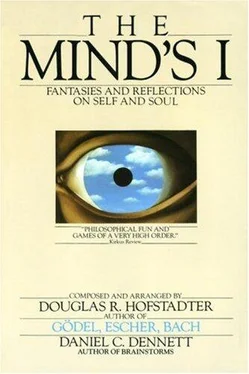PAT: Well, I certainly don’t think people are just fancy steam shovels of even electric can openers. There’s something about people, something that—that they’ve got a sort of flame inside them, something alive, something that flickers unpredictably, wavering, uncertain—but something creative!
SANDY: Great! That’s just the sort of thing I wanted to hear. It’s very human to think that way. Your flame image makes me think of candles, of fires, of thunderstorms with lightning dancing all over the sky in crazy patterns. But do you realize that just that kind of pattern is visible on a computer’s console? The flickering lights form amazing chaotic sparkling patterns. It’s such a far cry from heaps of lifeless clanking metal! It is flamelike, by God! Why don’t you let the word “machine” conjure images of dancing patterns of light rather than giant steam shovels?
CHRIS: That’s a beautiful image, Sandy. It changes my sense of mechanism from being matter-oriented to being pattern-oriented. It makes me try to visualize the thoughts in my mind—these thoughts right now, even—as a huge spray of tiny pulses flickering in my brain.
SANDY: That’s quite a poetic self-portrait for a spray of flickers to have come up with!
CHRIS: Thank you. But still, I’m not totally convinced that a machine is all that I am. I admit, my concept of machines probably does suffer from anachronistic subconscious flavours, but I’m afraid I can’t change such a deeply rooted sense in a flash.
SANDY: At least you do sound open minded. And to tell the truth, part of me does sympathize with the way you and Pat view machines. Part of me balks at calling myself a machine. It is a bizarre thought that a feeling being like you or me might emerge from mere circuitry. Do I surprise you?
CHRIS: You certainly surprise me. So tell us—do you believe in the idea of an intelligent computer, or don’t you?
SANDY: It all depends on what you mean. We have all heard the question “Can computers think?” There are several possible interpretations of this (aside from the many interpretations of the word “think”). They revolve around different meanings of the words “can” and “computer.”
PAT: Back to word games again.....
SANDY: That’s right. First of all, the question might mean “Does some present-day computer think, right now? To this, I would immediately answer with a loud “no.” Then it could be taken to mean, “Could some present-day computer, if suitably programmed, potentially think?” This is more like it, but I would still answer, “Probably not.” The real difficulty hinges on the word “computer.” The way I see it, “computer” calls up an image of just what described earlier: an air conditioned room with cold rectangular metallic boxes in it. But I suspect that with increasing public familiarity with computers and continued progress in computer architecture, that vision will eventually become outmoded.
PAT: Don’t you think computers, as we know them, will be around for a while?
SANDY: Sure, there will have to be computers in today’s image around for a long time, but advanced computers—maybe no longer called computers—will evolve and become quite different. Probably, as in the case of living organisms, there will be many branchings in the evolutionary tree. There will be computers for business, computers for schoolkids, computers for scientific calculations, computers for systems research, computers for simulation, computers for rockets going into space, and so on. Finally, there will be computers for the study of intelligence. It’s really only these last that I’m thinking of—the ones with the maximum flexibility, the ones that people are deliberately attempting to make smart. I see no reason that these will stay fixed in the traditional image. Probably they will soon acquire as standard features some rudimentary sensory systems—mostly for vision and hearing at first. They will need to be able to move around, to explore. They will have to be physically flexible. In short, they will have to become more animal-like, more self-reliant.
CHRIS: It makes me think of the robots R2D2 and C3PO in Star Wars.
SANDY: As a matter of fact, I don’t think of anything like them when I visualize intelligent machines. They’re too silly, to much the product of a film designer’s imagination. Not that I have a clear vision of my own. But I think it is necessary, if people are going to try realistically to imagine an artificial intelligence, to go beyond the limited, hard-edged image of computers that comes from exposure to what we have today. The only thing that all machines will always have in common is their underlying mechanicalness. That may sound cold and inflexible, but what could be more mechanical—in a wonderful way—than the operations of the DNA and proteins and organelles in our cells?
PAT: To me what goes on inside cells has a “wet,” “slippery” feel to it, and what goes on inside machines is dry and rigid. It’s connected with the fact that computers don’t make mistakes, that computers do only what you tell them to do. Or at least that’s my image of computers.
SANDY: Funny—a minute ago your image was of a flame, and now it’s of something “wet and slippery.” Isn’t it marvelous how contradictory we can be?
PAT: I don’t need your sarcasm.
SANDY: I’m not being sarcastic—I really do think it is marvelous.
PAT: It’s just an example of the human mind’s slippery nature—mine, in this case.
SANDY: True. But your image of computers is stuck in a rut. Computers certainly can make mistakes—and I don’t mean on the hardware level. Think of any present-day computer predicting the weather. It can make wrong predictions, even though its program runs flawlessly.
PAT: But that’s only because you’ve fed it the wrong data.
SANDY: Not so. It’s because weather-prediction is too complex. Any such program has to make do with a limited amount of data—entirely correct data—and extrapolate from there. Sometime it will make wrong predictions. It’s no different from the farmer in the field gazing at the clouds who says “I reckon we’ll get a little snow tonight.” We make models of things in our heads and use them to guess how the world will behave. We have to make do with our models, however inaccurate they may be. And if they’re too inaccurate, evolution will prune us out—we’ll fall over a cliff or something. And computers are the same. It’s just that human designers will seed up the evolutionary progress by aiming explicitly at the goal of creating intelligence, which is something nature just stumbled on.
PAT: So you think computers will make fewer mistakes as they get smarter?
SANDY: Actually, just the other way round. The smarter they get, the more they’ll be in a position to tackle messy real-life domains, so they’ll be more and more likely to have inaccurate models. To me, mistake making is a sign of high intelligence!
PAT: Boy—you throw me sometimes.
SANDY: I guess I’m a strange sort of advocate for machine intelligence. To some degree I straddle the fence. I think that machines won’t be really intelligent in a humanlike way until they have something like the biological wetness or slipperiness to them. I don’t mean literally wet—the slipperiness could be in the software. But biologically-seeming or not, intelligent machines will in any case be machines. We will have designed them, built them—or grown them! We will understand how they work—at least in some sense. Possibly no one person will really understand them, but collectively we will know how they work.
PAT: It sounds like you want to have your cake and eat it too.
SANDY: You’re probably right. What I’m getting at is that when artificial intelligence comes, it will be mechanical and yet at the same time organic. It will have that same astonishing flexibility that we see in life’s mechanisms. And when I say “mechanisms” I mean “mechanisms.” DNA and enzymes and so on really are mechanical and rigid and reliable. Wouldn’t you agree, Pat?
Читать дальше











